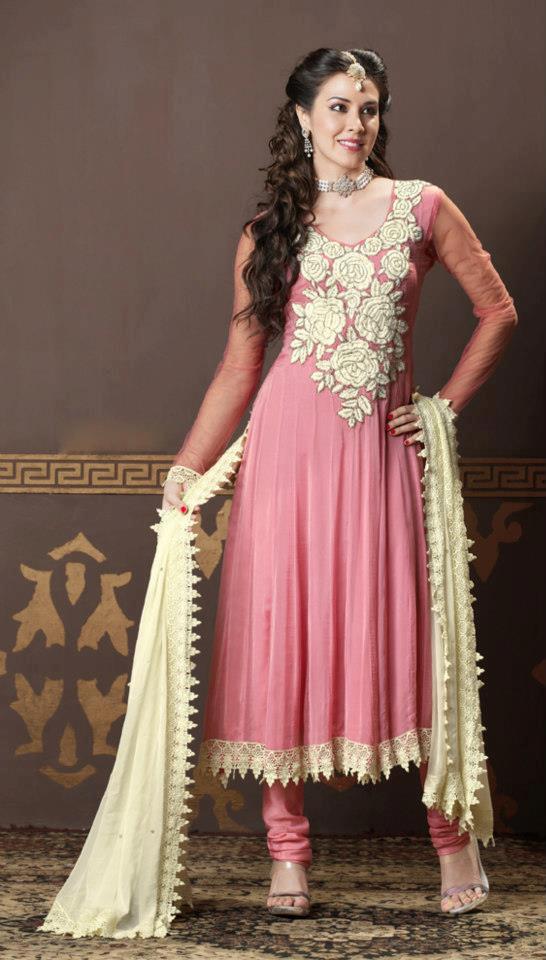Indian Dresses Biography
Source (google.com.pk)South Indian culture refers to the culture of the South Indian states of Karnataka, Tamil Nadu, Andhra Pradesh and Kerala. South Indian culture though with its visible differences forms an important part of the Indian culture. The South Indian Culture is essentially the celebration of the eternal universe through the celebration of the beauty of the body and motherhood.It is exemplified through its dance, clothing, and sculptures.South Indian women traditionally wear the sari while the men wear a type of sarong, which could be either a white dhoti or a colourful lungi with typical batik patterns. The sari, being an unstitched drape, enhances the shape of the wearer while only partially covering the midriff. In Indian philosophy, the navel of the Supreme Being is considered as the source of life and creativity. Hence by tradition, the stomach and the navel is to be left unconcealed, though the philosophy behind the costume has largely been forgotten.This makes the realization of sharira-mandala, where in Angikam bhuvanam yasya (the body is your world) unites with the shaarira-mandala (the whole universe), as expressed in the Natyashastra. These principles of the sari, also hold for other forms of drapes, like the lungi or mundu or anchey (a white lungi with colourful silk borders in kannada) worn by men. The lungi is draped over clockwise or counterclockwise and is tied at the back or fixed just along the waist line. It's sometimes lifted till knee and tied at the waist leisurely or just held in hand to speed up walking. In Andhra and in parts of north karnataka men wear kachche panchey where it is tied at back by taking it between legs.Similar pattern is seen in women. All over the peninsular coastal region men wear coloured lungis and women wear sari in a way tying it at back.The Araimudi (araimuti) was worn by young Tamil girls.
The Araimudi (araimuti) (Tamil: அரைமுடி, araimūḍi ?) is a small silver metal plate shaped like a heart or a fig leaf formerly worn by young Tamil girls on their genitals. "Arai" means loin and "mudi" means cover. The araimudi is also known as the "Genital shield" and an araimudi was mentioned in the "Guide to the principal exhibits in the Government Museum, Pudukkottai", by M. S. Chandrasekhar, published in 1966 as being displayed in an exhibit in the Madras Government Museum. "A Manual of the Salem district in the presidency of Madras, Volume 1" said "The children sometimes, to the age of ten years or more, go in a state of nudity, relieved perhaps by a piece of string round the waist which sustains the "araimudi" or heart-shaped piece of silver, which calls attention to what it purports to conceal." The "Madras district gazetteers, Volume 1, Part 1" said 'Little girls, up to the age of about 3, wear nothing but the little heart-shaped piece of silver suspended by a waist-cord (arai- mudi) " which calls attention to what it purports to conceal."'"Percival's Tamil-English dictionary", edited by P. Percival defined Araimudi as "அரைமுடி arai múḍi, A small plate of gold or silver, appended to the girdle of female children, for the sake of decency". Miron Winslow's dictionary, "A comprehensive Tamil and English Dictionary of High and Low Tamil" defined araimudi as "அரைமுடி, s. A small plate of metal worn by little girls over the private parts." Abbe Dubois's book "Hindu manners, customs and ceremonies", translated from French and edited by Henry Beauchamp stated that "Even the private parts of the children have their own particular decorations. Little girls wear a gold or silver shield or codpiece on which is graven some indecent picture ; while a boy's ornament, also of gold or silver, is an exact copy of that member which it is meant to decorate." "Description of the character, manners, and customs of the people of India; and their institutions, religious and civil", also written by Dubois said "The children of either sex are likewise ornamented with various trinkets of the same form, though smaller than those of grown persons. They have also some that are peculiar. As all children in India go perfectly naked till they are six or seven years old, the parents of course, adapt the ornaments to the natural parts of the body. Thus, the girls have a plate of metal suspended so as to conceal, in some measure, their nakedness. The boys, on the other hand, have little bells hung round them, or some similar device of silver or gold, attached to the little belt with which they are girt. Amongst the rest, a particular trinket appears in front, bearing a resemblance to the sexual part of the lad." Until the 1960s in the Ampara District of Sri Lanka girls wore the Araimudi.
Indian Dresses Designs for Men Women Girls 2013 Pakistani

Indian Dresses Designs for Men Women Girls 2013 Pakistani

Indian Dresses Designs for Men Women Girls 2013 Pakistani

Indian Dresses Designs for Men Women Girls 2013 Pakistani

Indian Dresses Designs for Men Women Girls 2013 Pakistani

Indian Dresses Designs for Men Women Girls 2013 Pakistani

Indian Dresses Designs for Men Women Girls 2013 Pakistani
Indian Dresses Designs for Men Women Girls 2013 Pakistani

Indian Dresses Designs for Men Women Girls 2013 Pakistani

nice collection dresses white one is so good.........buy women accessories online http://www.linoperros.com
ReplyDelete